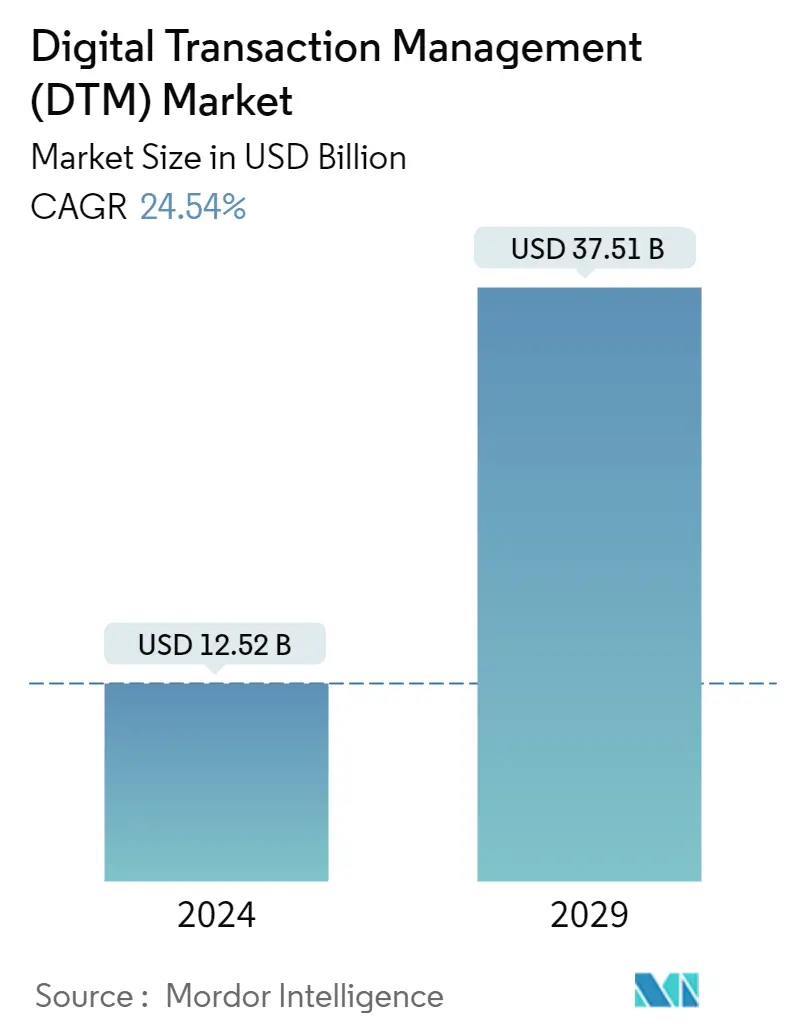Market Size of Digital Transaction Management (DTM) Industry

| Study Period | 2019 - 2029 |
| Market Size (2024) | USD 12.52 Billion |
| Market Size (2029) | USD 37.51 Billion |
| CAGR (2024 - 2029) | 24.54 % |
| Fastest Growing Market | Asia-Pacific |
| Largest Market | North America |
Major Players
*Disclaimer: Major Players sorted in no particular order |
Digital Transaction Management Market Analysis
The Digital Transaction Management Market size is estimated at USD 12.52 billion in 2024, and is expected to reach USD 37.51 billion by 2029, growing at a CAGR of 24.54% during the forecast period (2024-2029).
The spread of COVID-19 positively impacted the market initially due to the rise in remote working and growing digital transformation across businesses. Enterprises are seeking business methods that are seamless and efficient and can be done from anywhere.
- The adoption of DTM is increasing, and it is expected to absorb several parts of paper documents in the future. Most companies are embracing digital platforms to increase revenue and profitability. For instance, Salesforce adopted digital transaction management, and the company's sales organization experienced a USD 20 savings per document and a 60% reduction in turnaround times. The company also adopted electronic signature within their sales process, and the deal close time from an average of around two days down to about 90% of deals closing in one day and 71% closing in one hour.
- Business automation is a way to increase organizational efficiency by leveraging digital technologies to carry out all business processes with minimal human intervention. Technological advancements such as RPA and low-code Automation are paving the way for more secure transaction management solutions. For instance, Blockchain Technology provides a series of timestamped data records in the form of a chain linking all the documents. Every transaction can be considered proof of consent given by the user who initiated the transaction using digital signatures. The digital transaction management solutions built on blockchain technology use a decentralized network for transaction management to prevent malicious attacks.
- Increased adoption of cloud-based solutions would further positively impact the digital transaction management market. Small and large businesses must manage workflows on some level. Interdepartmental and cross-agency workflows are challenging as employees and managers may be on different systems that might perform substantial transfers. A cloud-based solution that allows every team member to interact with documents would make the digital transaction management process seamless and less costly. These cloud-based solutions speed up signing business agreements and contracts by digitalizing the process quickly, securely, and accurately.
- Increasing vulnerability related to Cyber-attacks and fraudulent digital transactions could restrain the market growth. Small businesses counter the risk of fraud and cyber-attacks because they lack the assets and cybersecurity safety measures compared to larger organizations. To avoid this potential risk, companies protect clients by providing them with the most up-to-date materials and regular cybersecurity check-ins.
- The COVID-19 pandemic negatively impacted the market with a forced adjustment in consumer and business spending patterns. The demand for contactless payments have increased through the use of mobile wallets to prevent the spread of the pandemic. Further e-commerce giants like Amazon, Flipkart, Myntra, etc., have also restricted cash payments. Such things strive for the growth of Digital Transaction Management. This trend is expected to continue even after the pandemic's impact. The companies look forward to offering higher values to gain a competitive edge in a highly competitive market.
Digital Transaction Management Industry Segmentation
Digital Transaction Management (DTM) is about moving from paper-based document processes to fully digital ones to enable the digital execution of transaction processes. DTM includes eSignatures, document transfer and certification, data and forms integration and management, and a variety of meta-processes around managing electronic transactions and the associated documents. Vendors are offering this solution and services for end-user industries such as BFSI, Healthcare, IT, and Telecom, among others considered in this study.
The Digital Transaction Management (DTM) Market is segmented by component (solution, service), organization size (small and medium enterprise, large enterprise), end-user industry (BFSI, healthcare, retail, IT, telecommunication, and other end-user industry types), and geography (North America, Europe, Asia Pacific, and rest of the world). The market sizes and forecasts are in terms of value (USD million) for all the above segments.
| By Component | |
| Solution | |
| Service |
| By Organization Size | |
| Small and Medium Enterprise | |
| Large Enterprise |
| By End-user Industry | |
| BFSI | |
| Healthcare | |
| Retail | |
| IT and Telecommunication | |
| Other End-user Industries |
| By Geography | |
| North America | |
| Europe | |
| Asia Pacific | |
| Rest of the World |
Digital Transaction Management (DTM) Market Size Summary
The Digital Transaction Management (DTM) market is experiencing significant growth, driven by the increasing need for seamless and efficient business processes that can be conducted remotely. The market's expansion is fueled by the widespread adoption of digital platforms by enterprises aiming to enhance revenue and profitability. Technological advancements, such as Robotic Process Automation (RPA) and low-code automation, are contributing to the development of more secure transaction management solutions. Blockchain technology, with its decentralized network, is playing a crucial role in ensuring secure transaction management by providing timestamped data records and digital signatures. The shift towards cloud-based solutions is further enhancing the DTM market, enabling businesses to manage workflows more efficiently and cost-effectively, thereby accelerating the signing of business agreements and contracts.
The banking, financial services, and insurance (BFSI) sector is undergoing a significant transformation due to the increasing adoption of digital solutions and cloud-based technologies. This shift is driven by the need to meet complex regulations, intense competition, and the demands of tech-savvy customers. The pandemic has accelerated the trend towards digital banking solutions, with a notable increase in digital transactions. Companies in the BFSI sector are moving away from traditional models to embrace digital platforms that offer real-time execution capabilities and value-added services. Government initiatives and regulations supporting e-signatures are also contributing to the market's growth. The competitive landscape is characterized by the presence of major players and innovative startups, with partnerships and technological advancements shaping the market dynamics.
Digital Transaction Management (DTM) Market Size - Table of Contents
-
1. MARKET DYNAMICS
-
1.1 Market Overview
-
1.2 Market Drivers
-
1.2.1 Rise in E-signatures and Adoption of Cloud Services
-
1.2.2 Focus on Business Automation
-
1.2.3 BFSI Industry is Expected to Hold a Significant Market Share
-
-
1.3 Market Challenges
-
1.3.1 Increasing Vulnerability Related to Cyber-attacks and Fraudulent Digital Transactions
-
-
1.4 Industry Attractiveness - Porter's Five Forces Analysis
-
1.4.1 Bargaining Power of Suppliers
-
1.4.2 Bargaining Power of Buyers
-
1.4.3 Threat of New Entrants
-
1.4.4 Threat of Substitutes
-
1.4.5 Intensity of Competitive Rivalry
-
-
1.5 Industry Valuechain Analysis
-
1.6 Assessment of COVID-19 Impact of on the Market
-
-
2. MARKET SEGMENTATION
-
2.1 By Component
-
2.1.1 Solution
-
2.1.2 Service
-
-
2.2 By Organization Size
-
2.2.1 Small and Medium Enterprise
-
2.2.2 Large Enterprise
-
-
2.3 By End-user Industry
-
2.3.1 BFSI
-
2.3.2 Healthcare
-
2.3.3 Retail
-
2.3.4 IT and Telecommunication
-
2.3.5 Other End-user Industries
-
-
2.4 By Geography
-
2.4.1 North America
-
2.4.2 Europe
-
2.4.3 Asia Pacific
-
2.4.4 Rest of the World
-
-
Digital Transaction Management (DTM) Market Size FAQs
How big is the Digital Transaction Management (DTM) Market?
The Digital Transaction Management (DTM) Market size is expected to reach USD 12.52 billion in 2024 and grow at a CAGR of 24.54% to reach USD 37.51 billion by 2029.
What is the current Digital Transaction Management (DTM) Market size?
In 2024, the Digital Transaction Management (DTM) Market size is expected to reach USD 12.52 billion.

